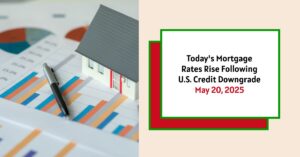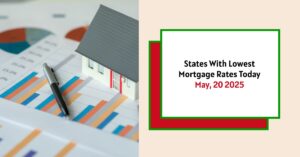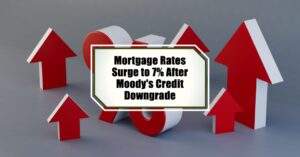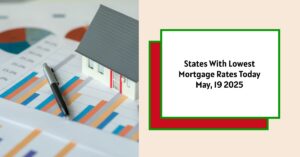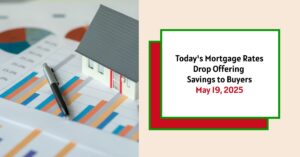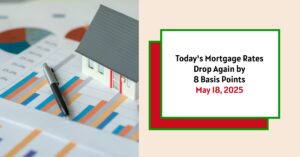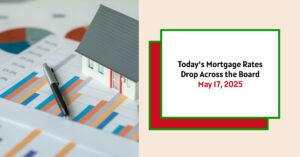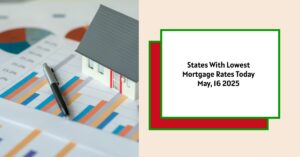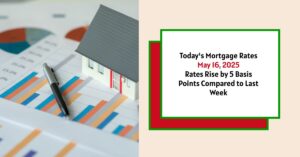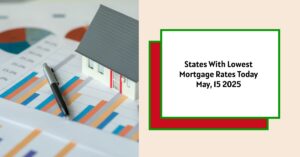As of May 20, 2025, mortgage rates have seen a significant increase, largely influenced by Moody's recent downgrade of the U.S. credit rating. The 30-year fixed mortgage rate now stands at 6.85%, while the 15-year fixed mortgage rate is at 6.07%. The rise in these rates can be attributed to the increased risk perceptions among investors following the downgrade, which has notably affected the yield on U.S. Treasury bonds and, consequently, mortgage rates.
Today's Mortgage Rates – May 20, 2025: Rates Jump Post Moody's Credit Downgrade
Key Takeaways
- Current Rates: 30-year fixed at 6.85%, 15-year fixed at 6.07%.
- Refinance Rates: 30-year refinance now at 6.90%.
- Market Influence: Rates are expected to remain elevated due to continued economic uncertainty.
- Credit Downgrade Impact: Moody's downgrade spurred worries regarding government debt levels, affecting market stability.
With the upward trajectory of mortgage rates, potential homebuyers and current homeowners looking to refinance are confronted with a challenging landscape. In this article, we’ll explore the current rates in detail, the factors influencing these changes, and what it means for borrowers.
Current Mortgage Rates as of May 20, 2025
The mortgage market has been particularly volatile, and current data from Zillow outlines the following national average rates for a range of mortgage products:
| Mortgage Type | Current Rate (%) |
|---|---|
| 30-Year Fixed | 6.85% |
| 20-Year Fixed | 6.44% |
| 15-Year Fixed | 6.07% |
| 5/1 Adjustable Rate Mortgage (ARM) | 7.17% |
| 7/1 Adjustable Rate Mortgage (ARM) | 7.38% |
| 30-Year VA | 6.38% |
| 15-Year VA | 5.71% |
| 5/1 VA | 6.35% |
For those considering refinancing, the rates are slightly higher, reflecting the current market pressures:
| Refinance Type | Current Rate (%) |
|---|---|
| 30-Year Fixed | 6.90% |
| 20-Year Fixed | 6.71% |
| 15-Year Fixed | 6.18% |
| 5/1 ARM | 7.50% |
| 7/1 ARM | 7.43% |
| 30-Year VA | 6.57% |
| 15-Year VA | 6.24% |
| 5/1 VA | 6.32% |
(Data sourced from Zillow).
Understanding the Recent Rate Increases
The recent spike in mortgage rates is primarily linked to a decision by Moody's to downgrade the U.S. government's credit rating from Aaa to Aa1. This rating downgrade was prompted by concerns over increasing national debt levels and fiscal stability. Moody's noted, “over the next decade, we expect larger deficits as entitlement spending rises while government revenue remains broadly flat,” which raises alarms for investors and lenders alike.
When investors perceive greater risk associated with U.S. government debt, yields on Treasury bonds rise. Because mortgage rates tend to follow these yields, any increase results in higher rates for prospective homebuyers and refinancers.
Current Market Sentiment and Trends
As of last week, the bond market reacted similarly to other economic factors, such as inflation expectations and ongoing geopolitical tensions. Given the interconnectedness of these factors, mortgage rates remain vulnerable to shifts in the economic landscape. Recently, concerns over inflation have heightened, making policymakers cautious in their approach. Economists and market analysts are in near consensus that rates might not only hold steady but could rise further in response to global economic conditions.
The Federal Reserve's decisions also play a crucial role in shaping mortgage rates. Notably, economists do not anticipate significant drops in mortgage rates before the end of 2025. In fact, many forecasters, including the Mortgage Bankers Association (MBA), project that the 30-year fixed mortgage rate could hover around 6.5% to 7.0% in the second half of the year. The Fed's current approach suggests they may prioritize controlling inflation over providing immediate relief to borrowers through lower rates.
Factors Influencing Mortgage Rates Beyond Credit Ratings
While the credit downgrade is a significant factor affecting mortgage rates, other elements also play a vital role:
- Economic Growth Indicators: Reports on GDP growth, consumer spending, and business investment provide insight into the economy's strength. A robust economy can lead to rising inflation, prompting the Fed to increase interest rates to cool off price increases.
- Job Market Dynamics: The labor market's health has direct implications on interest rates. An unemployment rate that stays low usually indicates higher consumer spending and investments, heightening inflation concerns. Conversely, weakening job growth could prompt a Fed response to lower rates in a bid to stimulate the economy.
- Geopolitical Tensions: Events abroad that affect energy prices or economic sanctions on major economies can ripple through to American markets, affecting borrower sentiment and rates. The interplay of international events with domestic economic health keeps lenders on their toes.
- Inflation Data: Economic news regarding inflation bears significant weight on the Fed's decisions. Rising inflation generally leads to higher mortgage rates as lenders seek to offset the expected decline in money's purchasing power.
- Housing Market Fundamentals: The dynamics of supply and demand in the housing market can exert upward pressure on rates. When housing inventory is low, prices rise, which can also affect how lenders view risk and set rates.
- Investor Sentiment: At its core, the mortgage market is deeply intertwined with investor sentiment. As risk appetite changes, lenders may raise rates to account for perceived risks in a volatile economic environment.
Expected Trends in Mortgage and Refinance Rates
The economic outlook is uncertain, but projections suggest that borrowers may find mortgage rates fluctuating around the levels witnessed today. For example:
| Forecasting Entity | Q2 2025 | Q3 2025 | Q4 2025 | Q1 2026 |
|---|---|---|---|---|
| Fannie Mae | 6.5% | 6.3% | 6.2% | 6.1% |
| MBA | 7.0% | 6.8% | 6.7% | 6.6% |
These forecasts provide a framework for understanding how rates may evolve influenced by a mixture of domestic fiscal policy, inflationary pressure, and shifts in economic growth expectations.
Comparative Analysis: Fixed vs. Adjustable-Rate Mortgages
When selecting between fixed-rate and adjustable-rate mortgages (ARMs), potential buyers should weigh the inherent risks and benefits. Fixed-rate mortgages grant borrowers the security of predictable monthly payments throughout the duration of the loan. Currently, the average rate for a 30-year fixed mortgage stands at 6.85%, while the 15-year fixed rate is significantly lower at 6.07%.
In contrast, ARMs often start at lower initial rates but transition to variable rates after a specified time, creating susceptibility to market fluctuations. For example, a 7/1 ARM offers a fixed rate for the first seven years but can adjust annually thereafter, currently sitting at 7.38%. Choosing this option can initially lower monthly payments; however, after the initial period, borrowers may face increased payments if rates rise.
Read More:
Mortgage Rates Trends as of May 19, 2025
Dave Ramsey Predicts Mortgage Rates Will Probably Drop Soon in 2025
Future of Mortgage Rates Post-Fed Decision: Will Rates Drop?
Fed's Decision Signals Mortgage Rates Won't Go Down Significantly
Monthly Payment Example Calculations
Understanding how different rates influence monthly payments is crucial for borrowers. Below, we illustrate the distinction in payments between a 30-year and 15-year fixed-rate mortgage using a hypothetical mortgage amount of $400,000:
- 30-Year Fixed Mortgage
- Rate: 6.85%
- Monthly Payment: Approximately $2,621
- Total Interest Paid: About $543,573 over 30 years
- 15-Year Fixed Mortgage
- Rate: 6.07%
- Monthly Payment: Approximately $3,391
- Total Interest Paid: About $210,303 over 15 years
This stark difference illustrates how opting for a shorter loan term can lead to substantial savings on interest payments. For many borrowers, the allure of lower interest over time needs to be balanced against higher monthly payments; it's a decision that requires careful financial consideration and goal setting.
The Future of Mortgage Rates: A Delicate Balance
Looking ahead, the trajectory of mortgage rates will be tightly linked with various economic indicators, including inflation, employment rates, and the Federal Reserve's policy stance. Borrowers should remain vigilant, as any shifts in these factors could lead to further rate fluctuations.
Interestingly, the expected trajectory doesn’t just hinge on macroeconomic indicators but also the overall behavior of consumers. For instance, should consumer confidence wane, we might see a slowdown in home purchases, prompting lenders to offer more competitive rates to stimulate demand.
Conversely, should inflation persist and the job market strengthen, lenders may be compelled to raise rates further to maintain profitability and offset the rising costs of borrowing. It’s a complex chess game where all players, from borrowers to lenders to investors, seem engaged.
The nuances of the current market demand that potential homeowners and those thinking about refinancing stay informed about emerging trends and data-driven projections in order to make sound financial decisions. Those actively engaged in the market would benefit from reviewing their options frequently and consulting financial experts as necessary.
Invest Smarter in a High-Rate Environment
With mortgage rates remaining elevated this year, it's more important than ever to focus on cash-flowing investment properties in strong rental markets.
Norada helps investors like you identify turnkey real estate deals that deliver predictable returns—even when borrowing costs are high.
HOT NEW LISTINGS JUST ADDED!
Connect with a Norada investment counselor today (No Obligation):
(800) 611-3060
Also Read:
- Will Mortgage Rates Go Down in 2025: Morgan Stanley's Forecast
- Expect High Mortgage Rates Until 2026: Fannie Mae's 2-Year Forecast
- Mortgage Rate Predictions 2025 from 4 Leading Housing Experts
- Mortgage Rates Forecast for the Next 3 Years: 2025 to 2027
- 30-Year Mortgage Rate Forecast for the Next 5 Years
- 15-Year Mortgage Rate Forecast for the Next 5 Years
- Why Are Mortgage Rates Going Up in 2025: Will Rates Drop?
- Why Are Mortgage Rates So High and Predictions for 2025
- Will Mortgage Rates Ever Be 3% Again in the Future?
- Mortgage Rates Predictions for Next 2 Years
- Mortgage Rate Predictions for Next 5 Years
- Mortgage Rate Predictions: Why 2% and 3% Rates are Out of Reach
- How Lower Mortgage Rates Can Save You Thousands?
- How to Get a Low Mortgage Interest Rate?
- Will Mortgage Rates Ever Be 4% Again?
